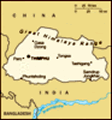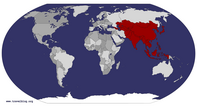Advertisement
Published: November 7th 2017
21.04.2017 Dochula Pass Dachula pass has 108 stupas or chortens. On road from Thimpu to Punakha.
Elevation 3,100 m (10,171 ft) Himalayas Mountain Range
The Dochula Pass is a mountain pass in the snow covered Himalayas within Bhutan on the road from Thimpu to Punakha where 108 memorial chortens or stupas known as "Druk Wangyal Chortens" have been built by Ashi Dorji Wangmo Wangchuk, the eldest Queen Mother. Apart from the chortens there is a monastery called the Druk Wangyal Lhakhang (temple), built in honour of the fourth Druk Gyalpo (head of the state of Bhutan), Jigme Singye Wangchuck; the open grounds in its front yard is a venue for the annual Dochula Druk Wangyel Festival.
The pass with 108 memorial chortens is adjacent to the country's first Royal Botanical Park.
Gangkar Puensum, the highest peak in Bhutan as seen from the Dochula Pass is located at an elevation of 3,100 metres (10,200 ft) (3,140 metres (10,300 ft)and 3,150 metres (10,330 ft) are also mentioned)
To the east of the pass, the snow clad mountain peaks of the Himalayas are seen prominently and among them is the Mt. Masanggang at 7,158 metres (23,484 ft) which is
the highest peak in Bhutan, known in local language as the Mt. Gangkar Puensum. The road east of the pass runs steep for some distance and then takes a left turn towards Punakha Valley to the Punakha Dzong, in Punakha (the old capital of Bhutan), which is located at the confluence of two rivers.
Further east the road reaches Wangdi Phodrong where there a 7th-century monastery on the ridge, and the valley is drained by the Punatsangchu River.
The weather at the pass generally remains foggy and chilly. However, between October and February, panoramic views of the Bhutan Himalayas can be seen.
The forest cover on the slopes of the pass consists of cypress trees. The hill slopes around the pass are festooned with a profusion of colourful religious flags fixed by the Buddhist people as a mark of veneration. The flags, made in five colours representing the natural forces, — "blue (sky), white (clouds), red (fire), green (water) and yellow (earth)" – are inscribed with Buddhist scriptural prayers to usher prosperity and peace around the country.
After the Losar festival in February, which marks the Bhutanese New Year, and as the snow melts, the pass
provides a spectacle of many species of flowers such as the Primal Denticulata, Primula Garcilipes and in the subsequent month rhododendrons bloom in profusion. Magnolia campbellii also bloom on the pass during this period. Another fragrant plant, which people come to enjoy, is the Daphne which is a small shrub which blooms with white flowers amidst an array of prayer flags that are fixed on the slopes. The bark of this plant is used to make paper which is a traditional paper used for writing religious scriptures as it is termite free.
The pass was filled with fog and while returning little clearness was there. It was a mystic view. We took many photos of nature.
Punakha Dzong Pungtang Dechen Photrang Dzong at Punakha is located in Bhutan Type Religious and Civil Administration.
Elevation 1,200 Construction started in 1637 Completed in 1638 Renovated in 2004
Structural system Fortress Floor count Six Design and construction Architect Zowe Palep and Ngawang Namgyal .
The Punakha Dzong, also known as Pungtang Dechen Photrang Dzong (meaning very awesome dzong "the palace of great happiness or bliss" is the administrative centre of Punakha District in Punakha, Bhutan. Constructed by Ngawang
Namgyal, 1st Zhabdrung Rinpoche, in 1637–38, it is the second oldest and second largest dzong in Bhutan and one of its most majestic structures. The dzong houses the sacred relics of the southern Drukpa Lineage of the Kagyu school of Tibetan Buddhism, including the Rangjung Kasarpani and the sacred remains of Ngawang Namgyal and the tertön Pema Lingpa.
Punakha Dzong was the administrative centre and the seat of the Government of Bhutan until 1955, when the capital was moved to Thimphu.
The Dzong is located at the confluence of the Pho Chhu (father) and Mo Chhu (mother) rivers in the Punakha–Wangdue valley.
The source of the Mo chu river is in the northern hills of Lighsi and Laya in Bhutan, and in Tibet. The Po Chu River is fed by glaciers in the Lunana region of the Punakha valley. After the confluence of these two rivers, the main river is known as Puna Tsang chu or Sankosh River and flows down through Wangdue Phodrang, crosses the Bhutan–India border at Kalikhola and eventually meets the Brahmaputra River.
Punakha is the winter capital of Bhutan. The head of the clergy of Bhutan with his entourage of
monks spend the winter in this dzong.
Jacaranda trees grow around the dzong, blooming with flowers in the spring.
As Punakha Dzong is located at only 1,200 meters, you will not suffer from oxygen shortages as you would in higher places such as Paro Taktsang (Tiger's Nest) Punakha is also the center of Bhutan’s longest suspension bridge (Punakha Suspension Bridge) and is about 7.5 km (4.5 miles) by car to Chimi Lhakhang, the Divine Madman’s fertility temple.
According to a local legend, the sage Padmasambhava prophesized that “a person named Namgyal will arrive at a hill that looks like an elephant”. Ngawang Namgyal, 1st Zhabdrung Rinpoche, found the peak of the hill, which appeared in the shape of trunk of an elephant as prophesized, and built the dzong in 1637-38.
Another legend tells how Zowe Palep, the architect, had a vision in a dream after the Zhabdrung ordered him to sleep under a small structure which contained a statue of the Buddha, known as Dzong Chug "small dzong". In his dream, prompted by the psychic powers of the Zhabdrung, he had a clear vision of a palace for Guru Rinpoche. The vision was imprinted on the
architect's mind, enabling him to conceive the plan for the dzong without putting the vision on paper and to build it. On the basis of the dream vision of the architect, the building of the dzong was started in 1637 and completed in 1638, at the place where the Dzong Chug had existed. During this period, Ngawang Namgyal became the first leader of a unified Bhutan, following his concerted efforts to unify the country into one unit.
The dzong was consecrated in the name of Pungthang Dechen Phodrang. In 1639, a commemorative chapel was erected to house the arms seized from the Tibetans who were defeated by the Bhutanese on this spot.
The Zhabdrung also set up a monastic order with 600 monks (brought from Cheri Gompa of upper Thimphu valley) and he lived here till his death.
The spire at the top of the utse (the dzong’s central tower or the main tower was added in 1676 by Gyaltsen Tenzin Rabgye–the abbot of the dzong. Further additions were made during the period 1744 to 1763, when Sherab Wangchuk was the ruler. A large thangka known as chenma (great) thoundral of the Zhabdrung was donated to the Dzong
by the Desi (ruler). This thangka is displayed during the tshechu held once a year here. The 7th Dalai Lama donated the brass roof for the dzong.
Several fires between 1750 and 1849 caused damages to the Dzong. In the 1897 earthquake, the dzong was severely damaged and also suffered numerous fires. In 1986, the dzong was partially destroyed by fire
Royal wedding article Wedding of Jigme Khesar Namgyel Wangchuck and Jetsun PemaThe wedding of the Druk Gyalpo, Jigme Khesar Namgyel Wangchuck, and his fiancée, Jetsun Pema, was held at the Punakha Dzong on 13 October 2011.
The dzong is part of the Drukpa Lineage of the Kagyu school of Tibetan Buddhism in Bhutan. It is the second oldest and most majestic dzong in Bhutan built at the orders of Ngawang Namgyal. It is a six-storied structure with a central tower or utse at an average elevation of 1,200 metres (3,900 ft) with a scenic, mountainous background. The materials used in building the Dzong consisted of compacted earth, stones and timber in doors and windows.
The dzong was constructed as an “embodiment of Buddhist values” and was one of the 16 dzongs built by the Zhabdrung
during his rule from 1594 to 1691. The dzong measures 180 metres (590 ft) in length with a width of 72 metres (236 ft) and has three docheys (courtyards). The defensive fortifications built in the dzong to protect it from enemy attacks consist of a steep wooden draw stairway and a heavy wooden door that is closed at night. After the dzong suffered damage due to a fire, a large prayer hall was added in 1986.
Punakha Dzong (interior view) Administrative offices of the dzong, a very large, white-washed stupa and a bodhi tree are located in the first courtyard. Also seen in the same courtyard, on the far left, are a mound of stones and a chapel dedicated to the queen of the nāgas.
The residential quarters of monks are located in the second courtyard, with the utse intervening in between the first and the second courtyards. There are two historic halls in this courtyard; one of Ugyen Wangchuk, who subsequently became the King and another hall where the King was decorated in 1905 with the Order of the Knight Commander of the Indian Empire by John Claude White. The third courtyard is at the
southernmost end of the dzong where the remains of Pema Lingpa and Ngawang Namgyal are preserved. Machey Lakhang ('machey' literally means "sacred embalmed body" in the third courtyard has the well preserved embalmed body of Zhabdrung. This Lakhang was rebuilt in 1995. The casket containing the embalmed body is not opened at all. However, the place is visited by the King and the Je Khenpo mainly to seek blessings before assuming their offices.
Flash floods resulting from glacial lake outburst flooding in the upper reaches of the valley, are a common occurrence in the Mo Chu and Pho Chu rivers, and in the past caused flooding and damage to the dzong, especially in 1957, 1960 and 1994. Fires and earthquakes have also further added to the problem. In 1996, flash floods in the Pho Chu river damaged the large stupa and caused several deaths.
After a major refurbishing work carried out in the "zorig chusum tradition" (an ancient tradition of crafts in wood carving, masonry, metal work, painting, and several other skills), the Dzong now has several new Lhakhangs, over 200 new religious images, and several other treasures. A consecration ceremony known as the “Rabney ceremony” performed by
His Holiness the Je Khenpo and the monks of the Dratshang (central monk body) was held from May 13 to 15, 2004, corresponding to the 12th to 14th day of the third Bhutanese month. The restoration works were largely funded by the Government of India and the Dzong stands fully restored to its past glory. After complete restoration of the Dzong to its old glory, notable images, statues and thangkas are displayed in the Dzong. These include murals depicting life story of Buddha done during the rule of the second druk desi. Large gilded statues of Buddha, Guru Rinpoche and Zhabdrung which belong to mid 18th century, and gilded panels on pillars are also here.
A covered wooden cantilever bridge crossing the Mo Chu river was built together with the Dzong in the 17th century. This bridge was washed away by a flash flood in 1957. In 2006, work started on a new wooden cantilever bridge in the traditional style, with a free span of 55 metres (180 ft). It was completed in 2008. In 2008, after completion of the cantilever bridge, the new bridge was hailed as a celebration of “100 years of Wangchuck Monarchy in
2008 and to the coronation of His Majesty King Jigme Khesar Namgyel Wangchuck in the Punakha Dzong”. Thus, the Dzong has been the venue for coronation of all the kings of Bhutan. A memorial honouring the 23 people who died in the dzong in the glacial floods in 1994 has also been erected just outside the dzong.
One thing we observed. In DZong the steps are so narrow and difficult to climb. It may be so to keep away enemies.We had lunch in the garden there. It is well maintained. Then we returned to our hotel in Thimpu.
Advertisement
Tot: 0.079s; Tpl: 0.014s; cc: 10; qc: 25; dbt: 0.0257s; 1; m:domysql w:travelblog (10.17.0.13); sld: 1;
; mem: 1.1mb


















